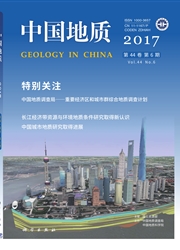

 中文摘要:
中文摘要:
木梓园钨矿床是赣南地区一中型石英脉型钨矿床,是利用地表云母线、石英线等矿化标志带寻找隐伏石英脉型矿床的典范。本文对木梓园矿床含黑钨矿石英脉石英中流体包裹体开展了岩相学和显微测温研究,并运用显微激光拉曼光谱测试技术对单个流体包裹体成分进行测试。结果表明,石英中流体包裹体至少记录了两期流体活动。这两类流体分属中-高温、中低盐度、中低密度的NaCl-H2O流体体系和中-低温、中低盐度、中等密度的NaCl-H2O流体体系。在木梓园钨矿床成矿流体的演化过程中,高温阶段发生了小规模的沸腾作用,并由此导致成矿流体中部分金属络合物分解进而沉淀成矿;低温阶段则主要经历了自然冷却过程,流体中矿质的沉淀则主要由温度的降低引起。
 英文摘要:
英文摘要:
The Muziyuan tungsten deposit is a medium-size quartz-vein type tungsten deposit in southern Jiangxi Province.The model using surface mica line and quartz line can be used in search for concealed quartz vein type ore deposit.Based on detailed petrographic observations,the authors carried out microthermometric and Raman microspectroscopic studies of fluid inclusions in wolframite-quartz veins of the Muziyuan tungsten deposit.Experimental results show that fluid inclusions in quartz have recorded at least two periods of fluid activities.These two kinds of fluid are of the high temperature,low salinity and low density NaCl-H2O fluid system and the low temperature,low salinity and medium density NaCl-H2O fluid system respectively.In the evolution process of ore-forming fluids in the Muziyuan tungsten deposit,high temperature stage experienced some boiling,resulting in the decomposition of the metal complex in ore forming fluids and ore deposition,whereas the low-temperature phase was mainly subjected to the natural cooling process,and the fluid mineral precipitation resulted mainly from the temperature decrease.
 同期刊论文项目
同期刊论文项目
 同项目期刊论文
同项目期刊论文
 Petrogenesis of the Xihuashan granites in southeastern China: Constraints from geochemistry and in-s
Petrogenesis of the Xihuashan granites in southeastern China: Constraints from geochemistry and in-s Ages and geochemistry of Laojunshan granites in southeastern Yunnan, China: implications for W-Sn po
Ages and geochemistry of Laojunshan granites in southeastern Yunnan, China: implications for W-Sn po SHRIMP U-Pb (zircon), Ar-Ar (muscovite) and Re-Os (molybdenite) isotopic dating of the Taoxikeng tun
SHRIMP U-Pb (zircon), Ar-Ar (muscovite) and Re-Os (molybdenite) isotopic dating of the Taoxikeng tun Age and Geochemistry of Granites in Gejiu area, Yunnan province, SW China: Constraints on their petr
Age and Geochemistry of Granites in Gejiu area, Yunnan province, SW China: Constraints on their petr Petrogenesis and geodynamic implications of Gejiu igneous complex in the western Cathaysia block, So
Petrogenesis and geodynamic implications of Gejiu igneous complex in the western Cathaysia block, So Timing of the formation of the Tianhuashan Basin in northern Wuyi as constrained by geochronology of
Timing of the formation of the Tianhuashan Basin in northern Wuyi as constrained by geochronology of Granite, gabbro and mafic microgranular enclaves in the Gejiu area, Yunnan Province, China: a case o
Granite, gabbro and mafic microgranular enclaves in the Gejiu area, Yunnan Province, China: a case o 期刊信息
期刊信息
